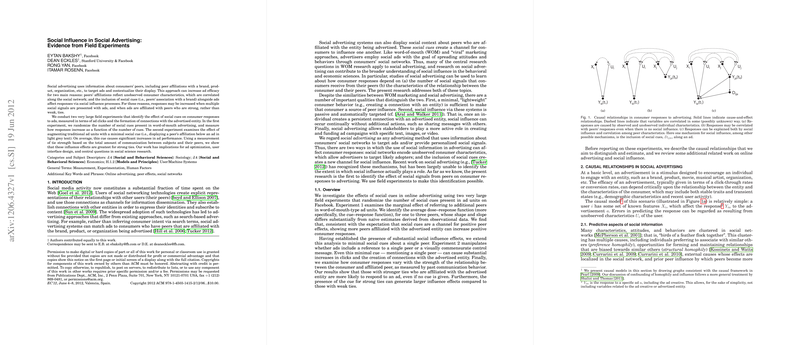An Analysis of Peer Influence in Social Advertising
The paper "Social Influence in Social Advertising: Evidence from Field Experiments" by Eytan Bakshy and colleagues presents an empirical investigation into the effects of social cues on consumer behaviors, specifically in the field of social advertising. This analysis is pivotal for understanding how social network data can optimize targeted advertising strategies. The researchers utilize two extensive field experiments to ascertain the role of social influence mediated by social cues in advertising on Facebook.
Methodology and Experimentation
The researchers conducted two large-scale experiments on Facebook that isolated the effects of social cues presented in ad interfaces. The first experiment examined the impact of varying the number of peers mentioned in sponsored story ad units. This manipulation aimed to unveil a cue-response function, measuring how response rates change with the number of social cues. Results indicated a significant increase in both ad clicks and “likes” as the number of social cues increased, consistent with theories predicting enhanced influence through multiple signals.
The second experiment focused on minimal social cues, such as displaying a peer's affiliation in small text below an ad, to assess their influence on consumer responses. Findings showed that even such minimal cues could lead to a notable increase in ad performance, highlighting the subtle yet significant impact of personalized social signals.
Numerical Findings and Implications
Quantitatively, the first experiment demonstrated up to a 10.5% increase in ad response when additional peers were mentioned, reinforcing the notion of positive peer influence. The second experiment revealed increases of 3.8% to 5.4% in click rates and 9.6% to 11.6% in like rates, attributed to the inclusion of minimal social cues. These results underscore the nuanced role of tie strength in social influence; stronger ties correlate with higher ad engagement and amplified cue effects.
Practical and Theoretical Implications
From an application standpoint, the research provides actionable insights for enhancing online advertising campaigns. By optimizing the display of social cues based on peer networks and the strength of interpersonal ties, advertisers can effectively leverage social influence to boost engagement. Theoretically, this work advances the understanding of social contagion models in networked environments, providing empirical evidence to support theories positing varied influence by tie strength and signal number.
Future Directions
Considering the paper's limitations, such as the non-randomization of tie strength and focus on specific social cue formats, future research could explore diversifying the presentation and context of social cues. Investigating demographic factors influencing the efficacy of social cues would also offer a more comprehensive view of personalized advertising strategies across different user segments. Furthermore, examining the long-term impact of repeated social cue exposures on brand loyalty and consumer behavior presents an intriguing avenue for subsequent studies.
In sum, Bakshy et al. provide a robust analysis of social influence mechanisms in digital advertising contexts, identifying critical pathways through which peer effects can be harnessed for strategic marketing outcomes. This work is indispensable for academia and industry professionals seeking to refine marketing tactics through data-driven insights into consumer behavior within social networks.
